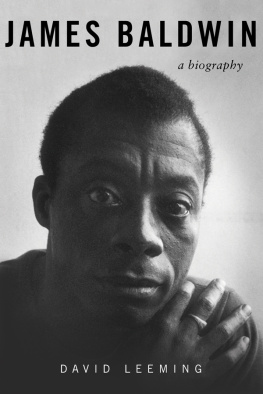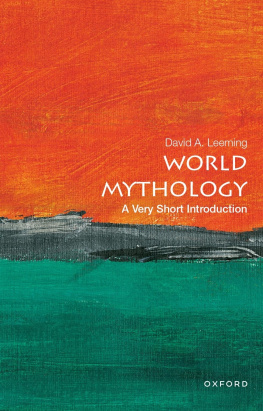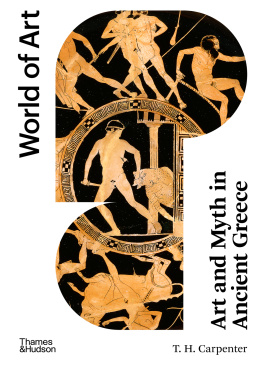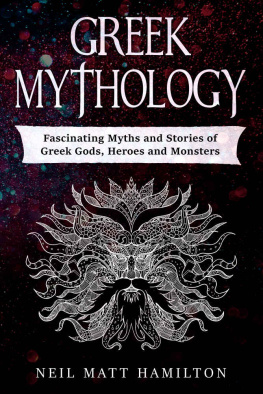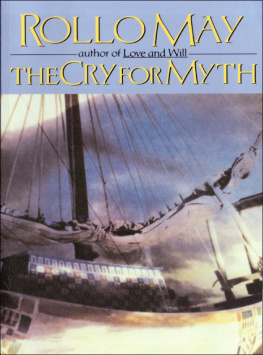SEX in the WORLD of MYTH

SEX
in the
WORLD
of
MYTH
DAVID LEEMING
REAKTION BOOKS
For Pam
Published by
REAKTION BOOKS LTD
Unit 32, Waterside
4448 Wharf Road
London N1 7UX, UK
www.reaktionbooks.co.uk
First published 2018
Copyright David Leeming 2018
All rights reserved
No part of this publication may be reproduced, stored in a retrieval system, or transmitted, in any form or by any means, electronic, mechanical, photocopying, recording or otherwise, without the prior permission of the publishers
Page References in the Photo Acknowledgements and
Index Match the Printed Edition of this Book.
Printed and bound in China by 1010 Printing International Ltd
A catalogue record for this book is available from the British Library
eISBN 978 1 78914 034 7
Contents

The Shaft Scene, Lascaux Cave painting, c. 17,000 BCE.
Preface
T HE APPROACH TO the subject of sex in myth will naturally involve explorations of mythologies from many sections of the world. This does not mean that all mythologies give equal time to sexual matters. Mythologies reflect our various individual and cultural approaches to sex. Like individuals, there are mythologies which revel in sexual stories, and others that are distinctly modest or even prudish where sex is concerned. I have not been able, of course, to include every culture or civilization, but I have covered the mythologies of several great civilizations of the past as well as lesser-known cultures in which sex plays a significant role. I have begun with the seminal civilizations of the Middle East and have moved from there to the Indo-European cultures of Europe and India, followed by the primarily animistic traditions of Asia, Africa, Oceania and the Americas.
The reader should not be surprised to find the myths of Christians, Jews and Hindus placed in the company of those of the ancient Greeks and Egyptians and those of such cultures as the African Dogon and the Native American Navajo. Sex is sex everywhere. All humans, and therefore all cultures, are concerned with it. Some tell explicit stories about it, while some veil these stories in metaphor. Some myths celebrate sex as the very reason for existence; some clearly despair of its power over our lives; some consider it inherently evil and demeaning; some find complex paths to denying it altogether.
The mythologies to which I have given most space are those that have been expressed fully in the written word. The characteristics and activities of the deities and heroes of Mesopotamia, Egypt, Israel, Canaan, Greece, Rome and India are revealed in detail in elaborate texts such as the Sumerian hymns to Inanna, the Babylonian Enuma Elish, the Epic of Gilgamesh, the Bible, the works of Homer, Hesiod, Aeschylus, Sophocles and Ovid, and the Vedas and epics of India. As it happens, these are the mythologies most concerned with sex.
The mythologies treated in much shorter chapters are generally those of animistic traditions in which deities and their activities are less clearly defined mythologies such as those of sub-Saharan Africa, Oceania and the Americas, and even China and Japan, which have been given some literary exposure only long after the establishment of the myths themselves. We have a much more intimate knowledge of Inanna, Gilgamesh, Medusa and Shiva than, for instance, of the Japanese goddess Amaterasu, the African trickster Ananse or the Native American Kokopelli, because of the strong literary traditions that have exposed them to us. In treating the mythologies of Africa, the Americas and, to some extent, Oceania, we are faced with such a large number of individual tribal groups that it has been necessary to consider these groups collectively, taking examples of sexual myths from large geographic areas.
As I have explored the sexual myths I have suggested ways in which these myths reveal cultural priorities, particularly in connection with gender relations and gender identity. In short, I have considered ways in which sex in myths has been used metaphorically for theological or moral purposes, or to justify cultural traditions. The tendency to compare as we move from one culture to another, however, leads inevitably to a consideration in a concluding chapter of certain universal themes that suggest a generally human myth of sex.

Auguste Rodin, The Kiss, 19014, marble.
Introduction:
Sex, Myth and Prehistory
T HE HUMAN SPECIES is at least partially defined by its ability to conceive of the relationship between past, present and future. Humans create plots narratives with beginnings, middles and ends. A significant aspect of our plot-making is sex, and sex is as important in our myths as it is in our lives. Myths are our cultural dreams, and since the beginning of time we have dreamed of sex. Myths, of course, also reflect other aspects of our existence, such as the need to understand how we and our world came into being and how we fit into the structure of the universe. But sex is pervasive in all mythologies because sex has obsessed us and confused us like no other element of our individual and social being. The very fact that for humans sex lies outside of the boundaries of the oestrus cycle that regulates the sexuality of other mammals makes our sexual appetite a central factor in our social existence, our rules of behaviour and, by extension, our myth-making.
As early as the Upper Paaeolithic period, humans were depicting their fixation with sex in paintings on cave walls and with sexual objects made of stone, bone or ivory. Archaeologists Marcos Garca-Dez and Javier Angulo, students of this primitive erotic art, go so far as to suggest that the sexual appetite conditions humans as a species.
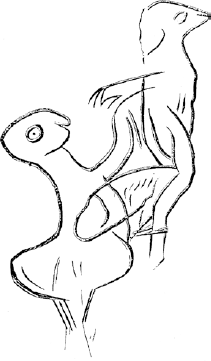
One of the earliest depictions of human coitus; cave of Los Casares, Spain, c. 40,000 BCE.
Whether the drawings of male and female genitals, hetero- and homosexual copulation and other sex acts were related to prehistoric myths is, of course, open to question. What the art even if some scholars dismiss it as mere graffiti does make clear is that from at least 40,000 years ago humans were fixated on sex as something more than a function of reproduction. Several scholars Joseph Campbell, Jamake Highwater, Sarah Dening and Marija Gimbutas among them have centred their attention on several hundred tiny female figurines found in various sites in Europe, Anatolia and elsewhere, to argue that there was, in fact, a sexual Palaeolithic and Neolithic mythology based on fertility and female power. Among the most famous of these figurines are the Palaeolithic Venuses of Willendorf in Austria, Hohle Fels in Germany (40,000 BCE), Laussel (c. 25,000 BCE) in the Dordogne region of France, and the Neolithic seated goddess of the Anatolian Asia Minor site at atal Hyk (c. 7500 BCE). These figurines have in common wide hips, huge breasts and vulvas in stylized triangles, all aspects suggesting sexuality and fertility and the dominance of the female in what these scholars see as matriarchal societies with female-based religions and associated myths in which sexuality was celebrated rather than repressed.


